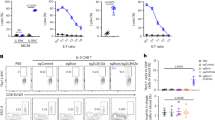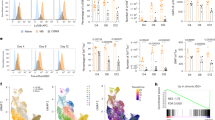Abstract
The ability of an animal to respond to a given antigenic peptide depends on its major histocompatibility complex (MHC) type1. Some peptides are not immunogenic when combined with a particular form of the MHC-encoded molecule. This non-responsiveness is regulated by immune response (Ir) genes and is thought to arise by one of two distinct mechanisms. Either the MHC-encoded molecules physically fail to interact with the antigen, preventing the activation of T cells with appropriate receptors, or they limit the expressed repertoire of T cell clones so that no T cells are available to be activated by existing complexes of MHC-encoded molecules and antigen2. Experimental evidence has been generated to support both mechanisms (reviewed in ref. 1). However, the relative importance of each has not been clearly established. In this study we started with a peptide that was immunogenic in BIO mice; it was thus known to be able to interact with the MHC molecule, and T cells existed which could recognise the peptide–MHC complex. Based on previous experiments3, we then changed only those parts of the peptide that we thought interacted with the T-cell receptor. All the new analogues created were still immunogenic, confirming that the amino-acid substitutions that we had made did not prevent productive interactions with the MHC-encoded molecule. No limitations ('holes') in the T-cell repertoire were found. The experiments demonstrate the vast potential of the T-cell population to recognize many different analogues, each in a unique way, and suggest that constraints on the diversity of the T-cell repertoire may not be a major explanation for Ir gene defects.
This is a preview of subscription content, access via your institution
Access options
Subscribe to this journal
Receive 51 print issues and online access
$199.00 per year
only $3.90 per issue
Buy this article
- Purchase on Springer Link
- Instant access to full article PDF
Prices may be subject to local taxes which are calculated during checkout
Similar content being viewed by others
References
Schwartz, R. H. Adv. Immun. 38, 31–201 (1986).
Schwartz, R. H. Nature 317, 284–285 (1985).
Schwartz, R. H. A. Rev. Immun. 3, 237–261 (1985).
Schwartz, R. H. et al. J. Immun. 135, 2598–2608 (1985).
Suzuki, G. & Schwartz, R. H. J. Immun. 136, 230–239 (1986).
Fink, P. J., Matis, L. A., McElligott, D. L., Bookman, M. & Hedrick, S. M. Nature 321, 219–226 (1986).
Schwartz, R. H. in Fundamental Immunology (ed. Paul, W. E.) 379–438 (Raven, New York, 1984).
Levine, B. B., Ojeda, A. & Benacerraf, B. Nature 200, 544–546 (1963).
Mills, K. H. G., Skehel, J. J. & Thomas, D. B. J. exp. Med. 163, 1477–1490 (1986).
Gammon, G. et al. Nature 319, 413–415 (1986).
Hansburg, D., Fairwell, T., Schwartz, R. H. & Appella, E. J. Immun. 131, 319–324 (1983).
Schwartz, R. H., Horton, C. L. & Paul, W. E. J. exp. Med. 145, 327–343 (1977).
Author information
Authors and Affiliations
Rights and permissions
About this article
Cite this article
Ogasawara, K., Maloy, W. & Schwartz, R. Failure to find holes in the T-cell repertoire. Nature 325, 450–452 (1987). https://doi.org/10.1038/325450a0
Received:
Accepted:
Issue Date:
DOI: https://doi.org/10.1038/325450a0
This article is cited by
-
Distorted Immunodominance by Linker Sequences or other Epitopes from a Second Protein Antigen During Antigen-Processing
Scientific Reports (2017)
-
Fine specificity of CD4+ T cell responses to the dominant encephalitogenic PLP 139-151 peptide in SJL/J mice
Neurochemical Research (1994)
-
Self-tolerance eliminates T cells specific for Mls-modified products of the major histocompatibility complex
Nature (1988)
-
Self-tolerance alters T-cell receptor expression in an antigen-specific MHC restricted immune response
Nature (1988)
Comments
By submitting a comment you agree to abide by our Terms and Community Guidelines. If you find something abusive or that does not comply with our terms or guidelines please flag it as inappropriate.



